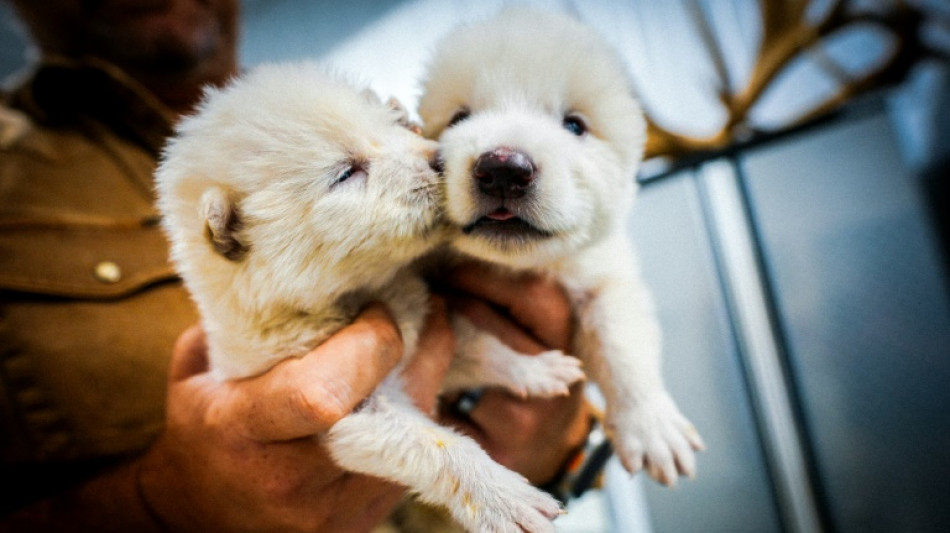
-
 Egypt officially opens grand museum near pyramids
Egypt officially opens grand museum near pyramids
-
French fraud watchdog reports Shein for 'childlike' sex dolls

-
 Scotland thrash USA before All Blacks' clash
Scotland thrash USA before All Blacks' clash
-
Five things to know about the Grand Egyptian Museum

-
 Bayern rest stars but ease past Leverkusen before PSG clash
Bayern rest stars but ease past Leverkusen before PSG clash
-
Dead quiet: Paris Catacombs close for renovations

-
 Families separated, children killed as survivors flee Sudan's 'apocalyptic' El-Fasher
Families separated, children killed as survivors flee Sudan's 'apocalyptic' El-Fasher
-
Napoli held by Como as Spalletti begins Juve adventure

-
 Southampton boss Still vows to fight on as pressure mounts
Southampton boss Still vows to fight on as pressure mounts
-
Borthwick hails 'ball of energy' Pollock as England down Australia

-
 Egypt opens grand museum in lavish, pharaonic ceremony
Egypt opens grand museum in lavish, pharaonic ceremony
-
Joao Pedro strikes at last as Chelsea edge past Spurs

-
 Ohtani to open for Dodgers in World Series deciding game seven
Ohtani to open for Dodgers in World Series deciding game seven
-
Understrength Bayern sail past Leverkusen before PSG clash

-
 Ramos header earns PSG late win over Nice
Ramos header earns PSG late win over Nice
-
Two more suspects including woman charged over Louvre heist

-
 Arteta hails Arsenal's 'exceptional' first half as leaders sink Burnley
Arteta hails Arsenal's 'exceptional' first half as leaders sink Burnley
-
Two more suspects charged over Louvre heist

-
 More than $2 mn in weapons seized in deadly Rio anti-drug raid: govt
More than $2 mn in weapons seized in deadly Rio anti-drug raid: govt
-
Feinberg-Mngomezulu guides South Africa to big win over Japan

-
 Sinner crushes Zverev to reach Paris Masters final, brink of No.1
Sinner crushes Zverev to reach Paris Masters final, brink of No.1
-
Pollock shines as England eventually overpower Australia

-
 Villarreal crush Rayo to move second, Atletico beat Sevilla
Villarreal crush Rayo to move second, Atletico beat Sevilla
-
Sinner crushes Zverev to reach Paris Masters final, brink of No. 1

-
 Pollock shines as England beat Australia in Autumn opener
Pollock shines as England beat Australia in Autumn opener
-
Ukraine sends special forces to embattled eastern city

-
 Arsenal cruise against Burnley as Man Utd held
Arsenal cruise against Burnley as Man Utd held
-
Pollock shines as England beat Australia 25-7 in Autumn Nations Series

-
 Gyokeres on target as leaders Arsenal beat Burnley
Gyokeres on target as leaders Arsenal beat Burnley
-
Woman charged over Louvre heist tears up in court

-
 Diomande dazzles as Leipzig go two points behind Bayern
Diomande dazzles as Leipzig go two points behind Bayern
-
Auger-Aliassime downs Bublik to reach Paris Masters final

-
 Villarreal crush Rayo to move second in La Liga
Villarreal crush Rayo to move second in La Liga
-
Female suspect, 38, charged in Louvre heist: AFP

-
 US not sending any high-level officials to COP30
US not sending any high-level officials to COP30
-
India captain Kaur sees World Cup final as possible turning point

-
 'Not out of the woods': What now for Britain's ex-prince Andrew?
'Not out of the woods': What now for Britain's ex-prince Andrew?
-
Tens of thousands of Serbians mark first anniversary of deadly train station collapse

-
 Tanzania president wins 98% in election as opposition says hundreds killed
Tanzania president wins 98% in election as opposition says hundreds killed
-
Vieira 'no longer' manager of troubled Genoa: club

-
 Tanzania president wins 98% of votes after violence-marred polls
Tanzania president wins 98% of votes after violence-marred polls
-
South Korea hosts Xi as Chinese leader rekindles fraught ties

-
 England's batting exposed as New Zealand seal ODI series sweep
England's batting exposed as New Zealand seal ODI series sweep
-
Funk legend turned painter George Clinton opens show in Paris

-
 Traditional mass wedding held in Nigeria to ensure prosperity
Traditional mass wedding held in Nigeria to ensure prosperity
-
Canada PM says Xi talks 'turning point', apologises to Trump

-
 Iranian tech prodigies battle it out with robots
Iranian tech prodigies battle it out with robots
-
Maldives begins 'generational ban' on smoking

-
 Explorers seek ancient Antarctica ice in climate change study
Explorers seek ancient Antarctica ice in climate change study
-
India's Iyer discharged from hospital after lacerated spleen


US firm says it brought back extinct dire wolves
They whimper, drink from baby bottles and crawl oh so tentatively -- they look like cute white puppies, not the fruit of a daring project to resuscitate an extinct species.
A Texas startup called Colossal Biosciences made a big splash this week by releasing footage of canines they say are dire wolves, a species that vanished more than 12,000 years ago.
"For the first time in human history, Colossal successfully restored a once-eradicated species through the science of de-extinction," the company states on its website.
Photos and video of these critters have flooded social media and shaken the scientific community, which has reacted with a mix of enthusiasm and skepticism over this experiment reminiscent of "Jurassic Park" -- the fictional story of a quirky rich man's attempt to bring back the dinosaurs.
The company says it did it by tweaking the DNA of a modern-day gray wolf with carefully chosen genes from dire wolf fossils. This modified genetic material was then inserted in a grey wolf egg and implanted in a common dog as a surrogate mom.
The result: three baby dire wolves, Colossal Biosciences claims.
"I think the claims are vastly overblown," Alan Cooper, an evolutionary molecular biologist who took part in a previous study of dire wolf DNA, told AFP.
"It would be like me putting a couple of genes into you from Neanderthals that made you extra hairy and grow more muscles, and then called you a Neanderthal," said Cooper.
"That's a million miles from Neanderthal. It's a hairy human."
"This is not the dire wolf. This is something they have created that has phenotypic characteristics of dire wolf,” said Lisette Waits, an ecologist and professor of wildlife resources at the University of Idaho.
Waits, who has worked extensively on grey wolf genetics and red wolf conservation issues, nonetheless called this achievement a breakthrough.
The pups are named Romulus and Remus, in a nod to the twin brothers of Roman mythology, and Khaleesi, of "Game of Thrones" fame.
- Debate -
The Colossal Biosciences team studied DNA from two dire wolf fossils -- a tooth from 13,000 years ago and a skull fragment dated back 72,000 years -- and compared them to the DNA of the gray wolf, a species that is alive and well.
The team concluded these two kinds of DNA are around 99.5 percent identical, Beth Shapiro, the company's chief science officer, told AFP.
An analysis of the differences between the two kinds of DNA determined which genes could be responsible for the dire wolf's size, muscle structure and its white fur.
With this information the team modified blood cells from a grey wolf by inserting some of those dire wolf genes. A total of 20 changes were made using the genetic manipulation technique known as Crispr-Cas 9, which is also used in human genetics.
The blood cells were then transferred to a gray wolf egg cell that was implanted in a dog. The results: Romulus, Remus and Khaleesi.
Whether these animals are actual dire wolves or simply genetically modified gray wolves, Shapiro insisted, "is a semantic, philosophical argument."
She added that it will never be possible to create an animal that is 100 percent genetically identical to a species that is extinct.
"But neither is that the goal. Our goal is to create functional equivalents of those species,” the scientist said.
- Dodos and wooly mammoths -
The company plans to apply this technique to dodo birds and woolly mammoths.
Just last month it released photos of mice injected with genetic material from one of those extinct pachyderms, yielding controversy and some very furry rodents.
Some scientists say the goal of recreating extinct species is unattainable and even dangerous. But others welcome it as an ambitious way to fight the planet's steady loss of biodiversity.
Waits, the conservation specialist, said that aside from the hoopla over this experiment this technique could help endangered species recover.
Colossal Biosciences has managed to lure more than $200 million in investment money, which would be a very tall task for other conservation causes, she added.
Ronald Sandler, a professor of philosophy and ethics at Northeastern University, said he worries this technique might lead to "moral distraction" away from the causes of animals going extinct, like climate change and habitat loss.
G.AbuHamad--SF-PST



